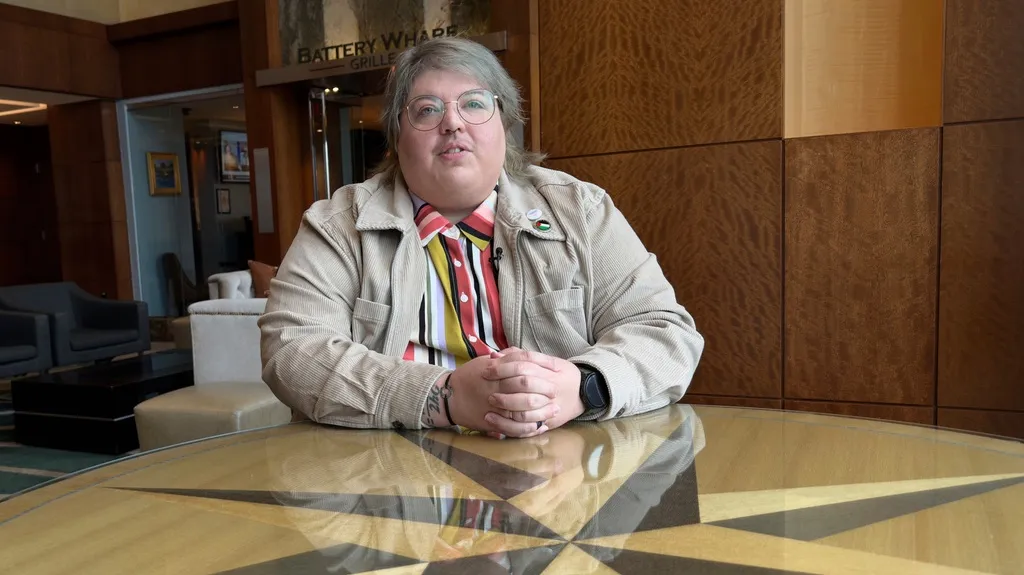April 8, 2016
State Lawmakers Don Alaska Native Garments
Rashah McChesney READ TIME: 3 MIN.
Every Friday during the Alaska legislative session, a growing group of state lawmakers trades suit coats and sweater sets for a loose-fitting traditional Alaska Native garment commonly called a kuspuk (KUH'-spuhk).
The kuspuk cuts vary almost as much as the trim chosen by the seamstress. Some have long sleeves, or are three-quarters length. Some are hooded, and others are long and worn as dresses rather than over pants.
All are part of a cultural tradition spanning generations among Alaska Native groups, who combined make up nearly 20 percent of the vast state's population.
Now, state lawmakers - Alaska Native or not - are incorporating their own traditions into the pattern-making process and wearing the garments every Friday, marking a seemingly small but significant cultural change at the Capitol, in a state where federal regulations once banned Alaska Native students from speaking their language in schools.
"Visually, I think it's a real nod to First Alaskans and their resourcefulness and practicality," said former legislator Mary Sattler, who grew up outside of Bethel, a remote town in far west Alaska.
For her and other Yup'ik Eskimos, the kuspuk is often part of a daily wardrobe. A five-term lawmaker in the House first elected in 1999, Sattler is credited with starting the Legislature's kuspuk tradition, but says she didn't do so singlehandedly.
Inupiat legislator Eileen MacLean occasionally wore her kuspuk during floor sessions before Sattler, she said.
MacLean, a Democrat from Barrow, was a teacher and advocate for Alaska Native rights. After she died in 1996, her daughter gifted Sattler with one of her kuspuks.
"They're just really practical and fun. So when I got into the Legislature it was hard not to want to wear one every day," Sattler said. "So I just kind of restricted myself to Friday."
Sattler can't pinpoint the year the tradition developed, but remembers that she started wearing kuspuks regularly to the Capitol in 2004.
Others began following her lead. From Democratic Anchorage Rep. Les Gara's sea-green, fish-patterned kuspuk to Rep. Matt Claman's cream-colored, oar-printed pullover, legislators personalized the tradition.
For lawmakers on the go, the large front pocket, a common addition to a kuspuk, is a handy storage place. Sattler said she would keep pens, her phone, schedule and anything else she needed for a day of meetings in the pocket.
Margaret Herron, who is Yup'ik and the wife of Rep. Bob Herron, D-Bethel, began sewing many of the kuspuks worn in the Capitol after word spread that she made the garments. She has a sewing machine waiting for her in Juneau when she treks across the state for a visit.
She doesn't take measurements before sewing. Instead, she guesses a person's size based on a small, medium or large pattern. An adult-sized kuspuk takes her about four to five hours to make.
"I just kind of wing it," she said. "I know some Yup'ik ladies can just look at you and know how to make it in your size."
Kuspuk Fridays have become a mainstay at the Capitol amid a wave of policy changes honoring the state's multi-cultural heritage, including a law passed two years ago that added 20 Alaska Native languages to the list of the state's official languages. Selina Everson, a Tlingit elder from Angoon, south of Juneau, just last month delivered an invocation on the House floor in both Tlingit and in English.
Everson, a Tlingit language and cultural preservation advocate, worked in Juneau for former Republican Gov. Jay Hammond in the 1970s.
"You didn't see kuspuks at the time. We didn't see anything like that," Everson said. "We've come a long way from the 70s, I would say."
For Eunice Hadley, who travels from Buckland, in northwest Alaska, to Juneau each year to advocate for her school district, the kuspuk tradition made her feel welcome.
On a recent Friday, Hadley sat on a bench near the gold-plated front doors of the Capitol, in a well-worn, red and purple paisley garment that her mother made more than a decade ago.
It's a source of comfort, Hadley said, when she is able to wear it while meeting with lawmakers. She said she was happily surprised to see members of the state government wearing a traditional garment the first time she visited.
"It's like they respect it," Hadley said.







